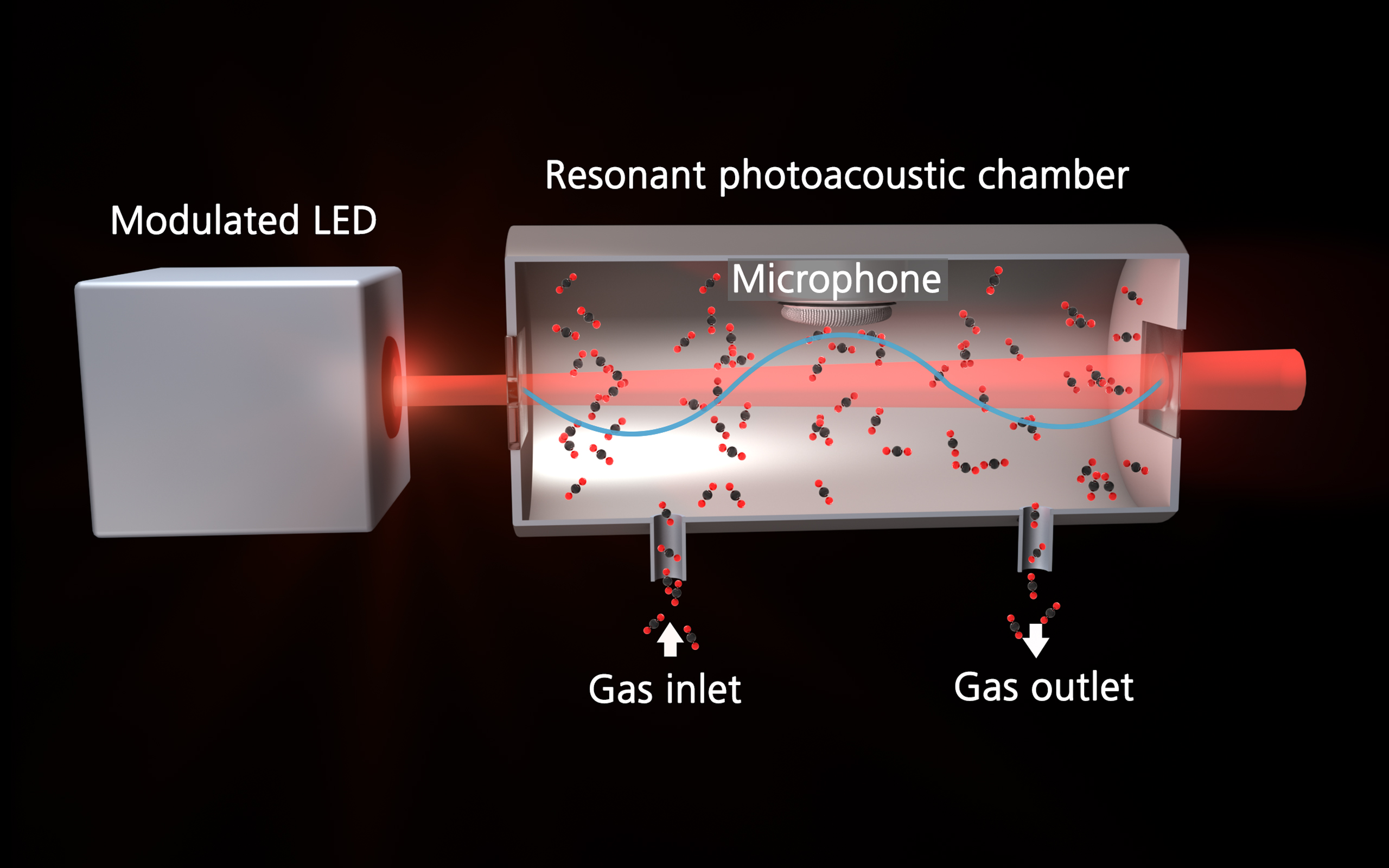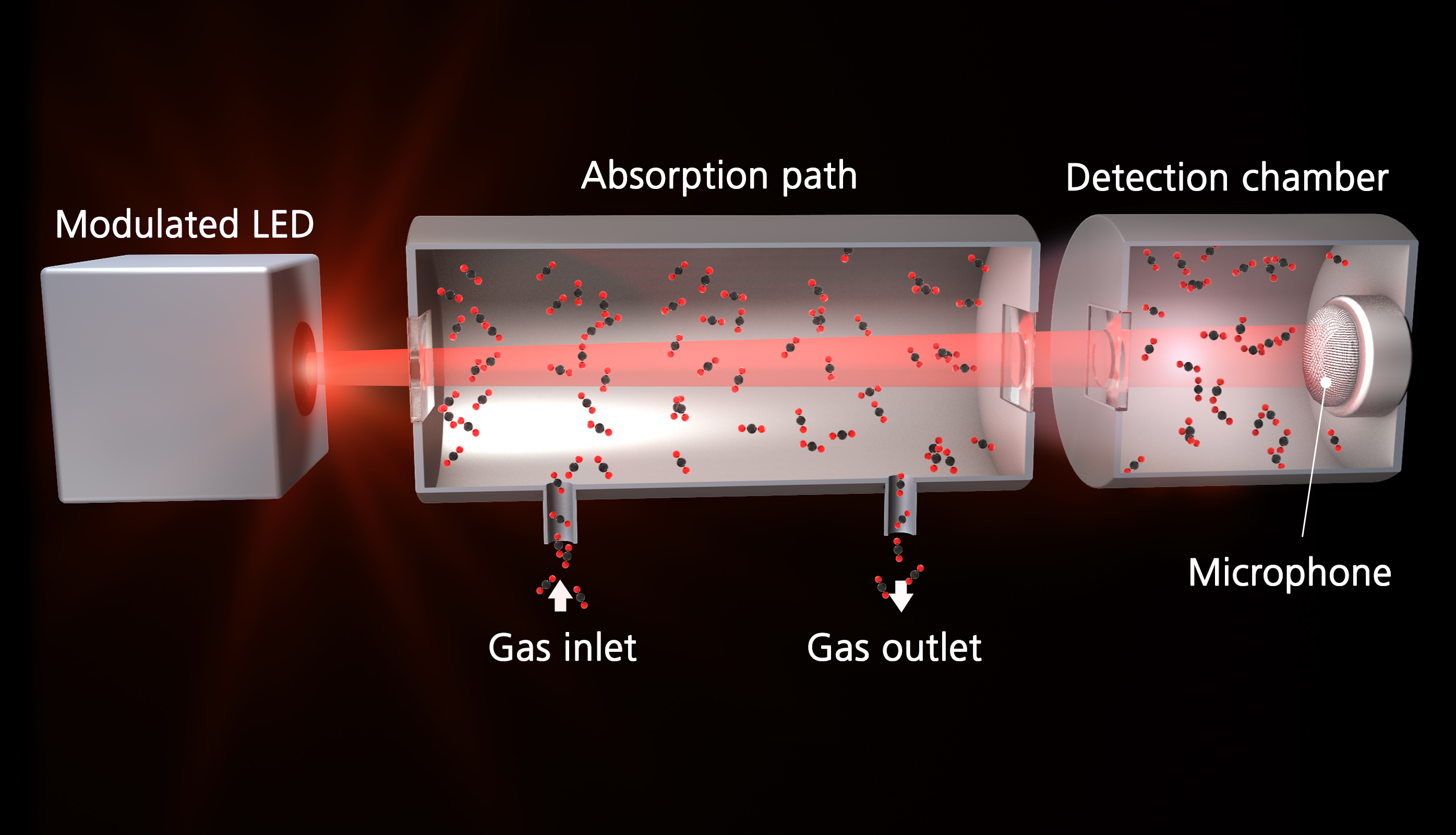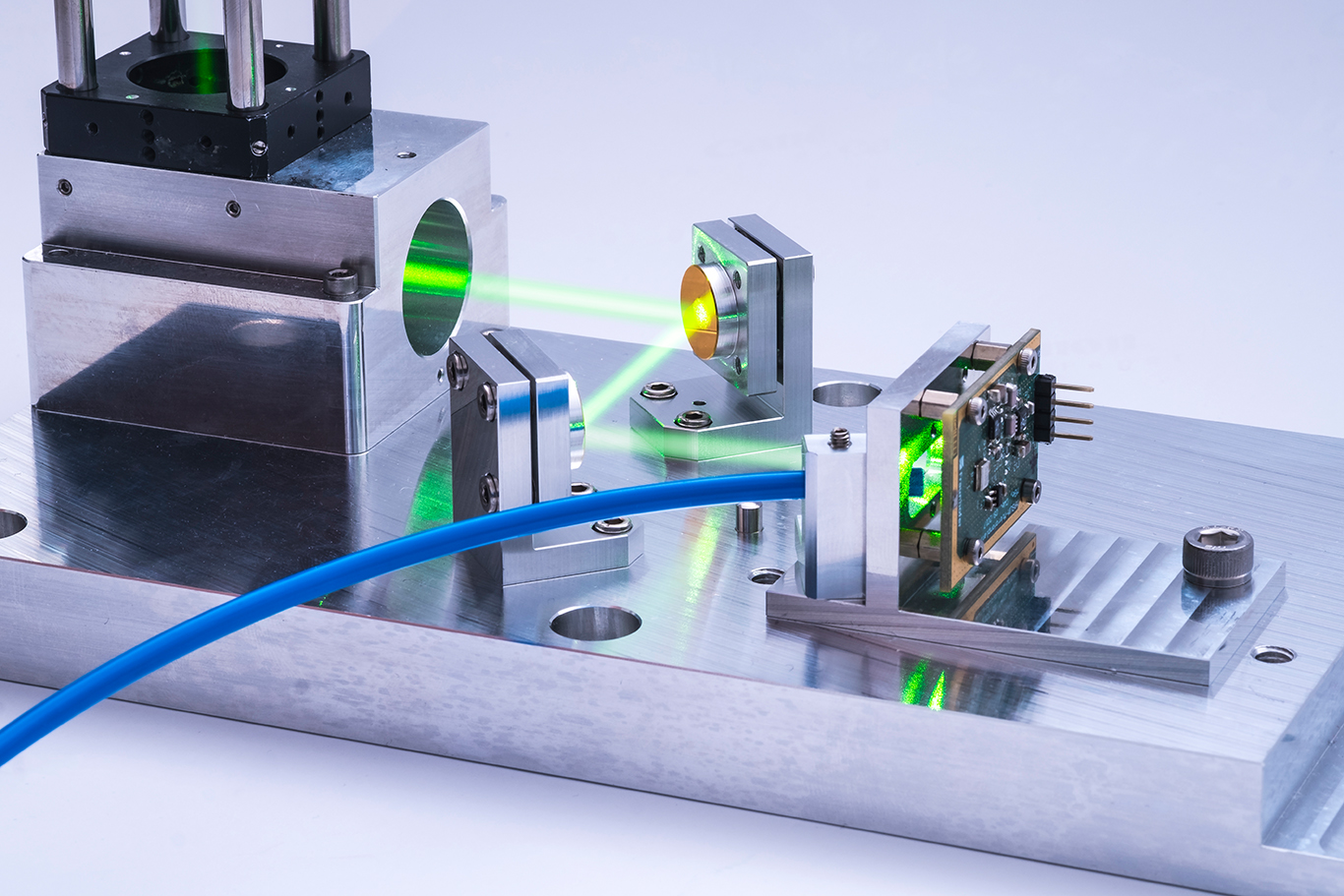Gases can be detected very precisely and selectively by means of photoacoustic spectroscopy (PAS). Alexander Graham Bell already described the basic measurement principle in 1880: If a gas sample in a measuring cell is irradiated with a pulsed light source, specific gas molecules will absorb the light and the gas sample will heat up. According to kinetic gas theory, a local increase in temperature leads to an increase in pressure. Periodic modulation of the intensity of the incident light beam causes periodic pressure fluctuations whose frequency matches the modulation frequency of the light source. These acoustic waves, i.e. the photoacoustic signal, can be detected with sound transducers (e.g. commercial MEMS microphones). The signal amplitude correlates with the strength of the absorption and thus provides information about the gas concentration in the measuring cell.
Photoacoustic spectroscopy


Resonant and non-resonant measuring cells
The geometry of the measuring cell is essential for the sensitivity of the photoacoustic detector. The detector can either be operated resonantly or non-resonantly. In resonant operation, the modulation frequency of the light source matches the acoustic resonance frequency of the measuring cell. This significantly amplifies the photoacoustic signal and thus increases the detection sensitivity.
In non-resonant operation of a photoacoustic detector, the modulation frequency of the light source (typically a broadband IR emitter) is far below the acoustic resonance frequency of the measuring cell. Non-resonant systems can be operated at different frequencies and are more stable with regard to changing pressure and temperature during operation.


LED, laser or IR-emitter as light source
Depending on the target gas and application, different geometries of measuring cells and different light sources are selected. Cost-effective measurement systems that use rapidly modulatable LEDs as light sources, for example, can already determine target gas concentrations very sensitively (in the 1 ppm range). If lasers are used as light source, the selectivity and sensitivity of the measurement systems are improved, often reaching values in the low ppb range.
Example: Photoacoustic SO2 measuring system
For a compact SO2 measurement system used for emission measurement in the exhaust gas scrubber on ships, Fraunhofer IPM employs a resonant measurement cell with a UV LED as light source. Thus, the required high resolution of 1 ppm in the measuring range up to 50 ppm SO2 is achieved.
Example: Minaturized photoacoustic CO2 sensor
For a miniaturized photoacoustic CO2 sensor used for the detection of indoor air quality, a non-resonant measuring cell was combined with a broadband IR emitter and a MEMS microphone. This allows a particularly small sensor with a sensitivity of 50 ppm and a wide measuring range up to 5000 ppm CO2.
Example: Laser-based photoacoustic measuring system for leak detection
A laser-based PA module with a resonant measuring cell has been developed for detecting gas leaks, for example from gas pipes in the ground. The operation of the measuring cell is actively stabilized, and concentrations of methane (CH4) and ethane (C2H6) are achieved with a resolution of a few ppb in each case.
Publications »Photoacoustic Spectroscopy«
| Jahr Year | Titel/Autor:in Title/Author | Publikationstyp Publication Type |
|---|---|---|
| 2025 | Optimizing Analog Front End Architectures for Enhanced SNR in Photoacoustic Imaging Kindorf, Sebastian; Weber, Christian; Bierer, Benedikt; Wöllenstein, Jürgen |
Konferenzbeitrag Conference Paper |
| 2025 | Design of a Refrigerant Leak Sensor based on the Photoacoustic Dual-Chamber Detection Method Yassine, Hassan; Weber, Christian; El-Safoury, Mahmoud; Brugger, Nicolas; Schmitt, Katrin; Wöllenstein, Jürgen |
Konferenzbeitrag Conference Paper |
| 2024 | Towards a Miniaturized Photoacoustic Sensor for Transcutaneous CO2 Monitoring El-Safoury, Mahmoud; Weber, Christian; Yassine, Hassan; Wöllenstein, Jürgen; Schmitt, Katrin |
Zeitschriftenaufsatz Journal Article |
| 2024 | Miniaturized two-chamber photoacoustic CO2 sensor with a wafer-bonded MEMS (micro-electro-mechanical systems) detector Gaßner, Simon; Essing, Simon; Tumpold, David; Schmitt, Katrin; Wöllenstein, Jürgen |
Zeitschriftenaufsatz Journal Article |
| 2024 | Photoakustische Detektion von BTEX-Komponenten im UV-Bereich Hamburger, Miguel; Herbst, Johannes; Strahl, Thomas; Brunner, Raimund; Weber, Christian; Schmitt, Katrin; Wöllenstein, Jürgen; Kondziella, Ralph |
Konferenzbeitrag Conference Paper |
| 2024 | Miniaturisierter CO2-Sensor mit wafer-gebondetem photoakustischen MEMS-Detektor Gassner, Simon |
Dissertation Doctoral Thesis |
| 2024 | Miniaturized Photoacoustic Sensors for the Detection of Trace Gases in Ambient Air Weber, Christian |
Dissertation Doctoral Thesis |
| 2024 | Improving the performance of artificial neural networks trained on synthetic data in gas spectroscopy - a study on two sensing approaches Goldschmidt, Jens; Moser, Elisabeth; Nitzsche, Leonard; Bierl, Rudolf; Wöllenstein, Jürgen |
Zeitschriftenaufsatz Journal Article |
| 2024 | Detection of SO2F2 Using a Photoacoustic Two-Chamber Approach Yassine, Hassan; Weber, Christian; Eberhardt, Andre; El-Safoury, Mahmoud; Wöllenstein, Jürgen; Schmitt, Katrin |
Zeitschriftenaufsatz Journal Article |
| 2023 | Photoacoustic methane detection inside a MEMS microphone Strahl, Thomas; Steinebrunner, Jonas; Weber, Christian; Wöllenstein, Jürgen; Schmitt, Katrin |
Zeitschriftenaufsatz Journal Article |
| 2023 | Resonant photoacoustic cells for laser-based methane detection Schmitt, Katrin; Sendelbach, Mara; Weber, Christian; Wöllenstein, Jürgen; Strahl, Thomas |
Zeitschriftenaufsatz Journal Article |
| 2023 | Evaluation of Photoacoustic Detectors for Methyl Bromide Sensing Yassine, Hassan; Weber, Christian; Wöllenstein, Jürgen; Schmitt, Katrin |
Konferenzbeitrag Conference Paper |
| 2023 | Miniaturized SMD-Reflow-Capable Photoacoustic CO2-Sensor Using a Dual-Chamber Approach Gaßner, Simon; Essing, Simon; Tumpold, David; Schmitt, Katrin; Wöllenstein, Jürgen |
Konferenzbeitrag Conference Paper |
| 2023 | Novel approach for efficient resonance tracking in photoacoustic gas sensor systems based on a light-induced wall signal Weber, Christian; Kapp, Johannes; Wöllenstein, Jürgen; Schmitt, Katrin |
Zeitschriftenaufsatz Journal Article |
| 2023 | How to Turn a MEMS Microphone Into a Photoacoustic Sensor: An Experimental Study Strahl, Thomas; Steinebrunner, Jonas; Weber, Christian; Wöllenstein, Jürgen; Schmitt, Katrin |
Konferenzbeitrag Conference Paper |
| 2023 | Towards a Miniaturized Photoacoustic Detector for the Infrared Spectroscopic Analysis of SO2F2 and Refrigerants Yassine, Hassan; Weber, Christian; Brugger, Nicolas; Wöllenstein, Jürgen; Schmitt, Katrin |
Zeitschriftenaufsatz Journal Article |
| 2022 | Verfahren und Sensor zum Bestimmen einer Konzentration eines Zielgases im Blut eines Lebewesens Schmitt, Katrin; Weber, Christian; Wöllenstein, Jürgen; Yassine, Hassan |
Patent |
| 2022 | Fluidmesszelle für einen photoakustischen Sensor Weber, Christian; Kapp, Johannes; Schmitt, Katrin |
Patent |
| 2022 | Gasmesszelle für einen photoakustischen Sensor und Verfahren zum Erfassen einer Eigenschaft eines Probengases Weber, Christian; Kapp, Johannes; Schmitt, Katrin; Strahl, Thomas; Sendelbach, Mara |
Patent |
| 2022 | Anodically Bonded Photoacoustic Transducer: An Approach towards Wafer-Level Optical Gas Sensors Gassner, Simon; Schaller, Rainer; Eberl, Matthias; Koblinski, Carsten von; Essing, Simon; Ghaderi, Mohammadamir; Schmitt, Katrin; Wöllenstein, Jürgen |
Zeitschriftenaufsatz Journal Article |
| 2022 | LED-basierter, miniaturisierter photoakustischer CO2-Sensor zur Umgebungsluftüberwachung Weber, Christian; Yassine, Hassan; Eberhardt, Andre; Schmitt, Katrin; Wöllenstein, Jürgen |
Konferenzbeitrag Conference Paper |
| 2022 | Miniaturisierter transkutaner Sensor für die Überwachung der CO2-Blutgaswerte El-Safoury, Mahmoud; Weber, Christian; Yassine, Hassan; Wöllenstein, Jürgen; Schmitt, Katrin |
Konferenzbeitrag Conference Paper |
| 2022 | Resonante photoakustische Zellen zum laserbasierten Methannachweis Schmitt, Katrin; Sendelbach, Mara; Strahl, Thomas; Weber, Christian; Wöllenstein, Jürgen |
Konferenzbeitrag Conference Paper |
| 2021 | Comparison of laser-based photoacoustic and optical detection of methane Strahl, Thomas; Herbst, Johannes; Maier, Eric; Rademacher, Sven; Weber, Christian; Pernau, Hans-Fridtjof; Lambrecht, Armin; Wöllenstein, Jürgen |
Zeitschriftenaufsatz Journal Article |
| 2021 | On-Board Monitoring of SO2 Ship Emissions Using Resonant Photoacoustic Gas Detection in the UV Range El-Safoury, Mahmoud; Dufner, Miguel; Weber, Christian; Schmitt, Katrin; Pernau, Hans-Fridtjof; Willing, Bert; Wöllenstein, Jürgen |
Zeitschriftenaufsatz Journal Article |
| 2020 | Gassensor-basiertes Analysesystem zur Bestimmung des Reinheitsgrades von Kältemitteln (CONTECT-R). Schlussbericht El-Safoury, Mahmoud; Weber, Christian |
Bericht Report |
| 2020 | Smart Technologies for Indoor Environmental Quality Control Ortiz Pérez, Alvaro |
Dissertation Doctoral Thesis |
| 2020 | Miniaturized photoacoustic detection of organofluorine-based refrigerants El-Safoury, Mahmoud; Weber, Christian; Kiesewetter, Olaf; Hespos, Yvonne; Eberhardt, André; Schmitt, Katrin; Wöllenstein, Jürgen |
Zeitschriftenaufsatz Journal Article |
| 2020 | The Optimization of a Photoacoustic Refrigerant Sensor System Using a Three-Chamber Concept El-Safoury, Mahmoud; Weber, Christian; Wöllenstein, Jürgen; Kiesewetter, Olaf |
Konferenzbeitrag Conference Paper |
| 2020 | Micro PA detector: Pushing the limits of mid IR photoacoustic spectroscopy integrated on silicon Coutard, Jean-Guillaume; Berthelot, Audrey; Glière, Alain; Lhermet, Hélène; Scherer, Benjamin; Strahl, Thomas; Teulle, Alexandre; Verdot, Thierry |
Konferenzbeitrag Conference Paper |

